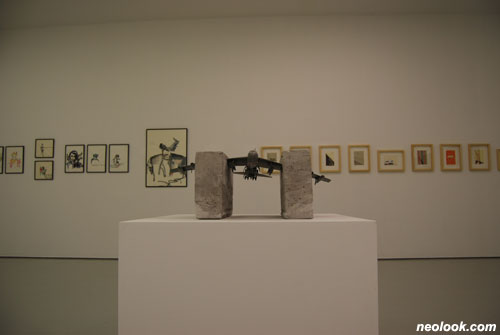- ● homepage
- ● archives
- ● restoration
- ● books
- ● big banners
- ● post board
- ■ neo's search
- ■ about us
- ■ 게재방법 안내
- 개인정보처리방침

- [email protected]
- Tel. 02_335_7922
- Fax. 02_335_7929
- 10:00am~04:30pm
- 월요일~금요일
- 3/3(월) 대체공휴일

Human Work
최대진展 / CHOIDAEJIN / 崔大珍 / mixed media 2011_1124 ▶ 2011_1225

- 최대진_Museum of contemporary art_LYON_2008
초대일시 / 2011_1124_목요일_06:00pm
작가와의 대화 / 2011_1208_목요일_03:00pm
주최,기획 / 대안공간 루프 후원 / 한국문화예술위원회
관람시간 / 11:00am~08:00pm
대안공간 루프 ALTERNATIVE SPACE LOOP 서울 마포구 서교동 335-11번지 Tel. +82.2.3141.1377 www.altspaceloop.com
"모든 예술은 어느 정도 프로파간다이다." 인간의 권력과 그에 대한 욕망을 신랄한 문체로 고발했던 조지 오웰의 말이다. 물론 그였기에 할 수 있었던 말이지만, 이 말에는 상당한 일리가 있으며 지금 이 시대에도 적용할 수 있는 여지가 있다. 더욱이 '선전'의 의미를 더는 집단적 의미로 해석하기 어려운 때가 되었으니 말이다. 사람들은 예술의 기원을 따질 때, 어김 없이 '주술적 의미'를 든다. 그리고 여기에 최초의 프로파간다가 함유되어 있음을 부인하지 못한다. 16세기 로마에서 처음으로 등장한 '프로파간다'는 나열된 단어들 속에서 해방되어 '신앙을 전파하는 메시지'를 뜻하는 하나의 고유명사가 되었으며, 인간사의 우여곡절을 겪어내며 결국 포괄적인 일반명사가 되었다. 그리고 그것 안에서 방점을 찍던 집단성이 그 무게를 덜어냄으로써 보다 더 포괄적이고 보편적인 단어로 화했다.

- 최대진_Panmunjom_혼합재료_28×130×45cm_2009
우리는 현재 우리가 목격할 수 있는 인류 최초의 예술행위들 속에서 프로파간다를 발견할 수 있으며, 단적으로 그것을 드러내는 작품으로 고대 벽화를 말할 수 있다. 거친 필선과 치졸한 표현법 거기에다 당대에 약속된 상징성을 드러내는 형상 혹은 문자들의 나열. 이러한 벽화는 가장 이해되기 쉬운 방식으로 그려졌고, 또한 전달되었다. 그리고 그 장르의 특성으로 멕시코에서는 하나의 운동으로 발전하였으며, 지금도 수많은 익명의 예술가에 의해 새로운 프로파간다를 전달하는 생생한 수단으로 활용되고 있다. 이러한 기나 긴 시간을 통한 이해 덕분일까? 작가 최대진의 벽화와 드로잉 작업에서는 매체와 메시지가 일치되는 경험을 하게 된다. 이는 작업 자체를 노동으로 해석하는 작가의 의지가 발현된 타이틀 'Human Work'에서도 마찬가지이다.

- 최대진_Museum of Contemporary Art_SAINT-ETIENNE_2009
우선 최대진의 작업을 해석할 때 가장 먼저 상기하게 되는 것은 칼 마르크스와 한나 아렌트의 '노동에 대한 생각들'이다. 작가가 '노동'에 대해 지니고 있는 견해는 마르크스의 '노동과 소외'의 문제와 일견 유사해 보인다. 우선 예술가가 창조한 작품에 대한 해석은 관객의 몫이 된다는 것이 그것이며, 여러 예술인으로 하여금 창작 행위를 가능토록 하는 동인이 외부에 존재하고 있을 가능성이 높다는 것이 두 번째이며, 창작 행위 자체가 순수한 쾌를 부여하지 못한다는 것이 세 번째 이유이다. 그리고 여기서 한나 아렌트의 견해를 빌리자면, 예술가가 행위하는 '제작인'으로 인정받지 못하고 노동하는 '동물'로 취급될 때, 부분적으로 느끼고 있던 고립 상태는 고독감으로 발전한다는 것 또한 그러하다. 결국 아렌트는 이러한 고독이 대중으로 하여금 전체주의를 요청하였으며, 강한 독재자의 등장을 초래하는 계기로 작용하였음을 역설한 바 있다. 이러한 내용들은 최대진의 작업 속에서 뫼비우스의 띠처럼 원인과 결과가 서로 맞물리는 상태로 등장하고 있다.

- 최대진_Metropolis Gallery_PARIS_2010
인간은 생존하기 위해 노동하는가? 노동을 위해 생존하는가? 노동의 소외 문제가 본격적으로 대두된 이후부터 이 문제는 지금까지도 명확한 해답을 얻지 못한 상태로 남아 있다. 그리고 인간은 집단 속에 머무르며, 하나의 원자로 행위하기를 원하는가? 또렷한 개체로 탈출하기를 원하는가? 역시 마찬가지이다. 이번에 그가 보여주게 될 작업들을 대표하는 이미지로 볼 수 있는 전쟁 이후의 카셀의 풍경에는 전체주의의 모순이 단적으로 표출되어 있지만, 그 안에는 그러한 거대 사건을 가능케 한 개인들의 인정에 대한 욕망 역시 드러나고 있다. 그리고 우리는 시대적 사건을 새롭게 해석하고 작품에 반영하는 이가 그 시간과 공간으로부터 분리되어 있는 작가라는 사실을 이미 알고 있다. 하지만 이러한 괴리감은 현재 이곳에 살아가는 우리로 하여금 그의 작업을 통해 역사와 사건 그리고 지금껏 영향력을 행사해오고 있는 여러 요소에 대해 새롭게 고민하고 의미 부여하도록 하는 요인이 되어주고 있다. 어찌 보면, 악셀 호네트의 말처럼 인정에 대한 욕망이 개인을 집단 속으로 걸어가도록 하며, 그 안에서 역사를 뒤흔드는 거대한 사건을 만들어낸 것인지도 모르겠다. 결국 최대진의 'Human Work'는 지극히 개인적인 노동으로부터 시작되어 인류의 거대한 사건에 이르는 포괄적인 이야기들을 지극히 개인의 시각과 감성으로 필터링하여 세상에 내어놓은 한 편의 서사시로 볼 수 있을 것이다. ■ 김지혜

- 최대진_Louvre Museum_PARIS_2011
"All art is propaganda," said George ORWELL, who authored many biting satires centered on a struggle and desire for power. His insight is true and more than applicable to today's society, especially now that it has become difficult to interpret propaganda in a collective sense. People without exception highlight the shamanistic aspect of art when trying to trace its origin. Undeniably, it was humankind's very first form of propaganda. The term propaganda, which came to be used in the 16th century Rome, was at first a proper noun that referred to "the message spreading the faith"; it later became a common noun as it underwent twists and turns of history. With its singular collective connotation removed, it was transformed into a more comprehensive, universal word.
● We can discover traces of propaganda in early forms of art, and the example that readily comes to mind is the ancient mural. Ancient murals are characterized by rough strokes, crude representations, and rows of symbols or pictographs standing for words. Such murals were always created in the most straightforward and simple manner for the audience to capture their messages easily. That is why there occurred a movement among Mexican artists to employ murals as a means to convey propaganda; an increasing number of anonymous murals still appear throughout the nation to this day. Artist CHOI Dae Jin also seems to be grasping a clear understanding of such attributes, and, probably for that reason, his murals and drawings serve as the perfect media for the messages he intends to deliver.
Vol.20111127e | 최대진展 / CHOIDAEJIN / 崔大珍 / mixed media
